|
FAQs about Identification of Caryophyllid
Corals
1
Related Articles:
Caryophyllid Corals, Elegance Coral,
Related FAQs: Elegance
Coral Identification, Caryophylliids 1, Caryophylliids 2, Caryophylliids 3, Caryophylliids 4, Caryophyllid Compatibility, Caryophyllid Systems, Caryophyllid Selection, Caryophyllid Behavior, Caryophyllid Feeding, Caryophyllid Disease, Caryophyllid Propagation/Reproduction,
Stony/True Coral, Coral System Set-Up, Coral System Lighting, Stony Coral Identification, Stony Coral Selection, Coral Placement, Foods/Feeding/Nutrition, Disease/Health, Propagation, Growing Reef Corals, Stony Coral Behavior,
|
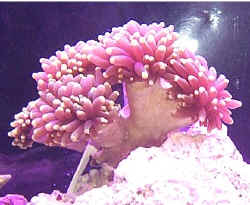
|
|
Coral ID 4/26/17
Wondered if you can tell me if this is Montastrea or a hidden cup, aka
Phyllangia? It's from the Gulf of Mexico. Thanks
<Does appear to be Phyllangia from the shaped of the corallites, their
clustering and extended polyps. Bob Fenner>
|
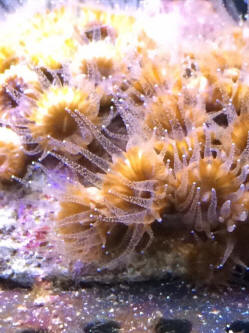 |
|
Coral ID 4/21/15
Hey Bob, Robert George Peets posted this coral in one of the FB groups.
Collected off the coast of Bermuda about 30' down. Said the piece that
was around 5' wide.
<Five feet?!>
It has not opened all the way but did eat some Mysis. Thought you might know. He
has been involved in coral conservation programs in Bermuda for 12 years and has
no idea what it is. Help would be appreciated.
Thanks,
Lori Johnson
<Mmm; well; the size of polyps, color, the stated shape of the colony... may be
Eusmilia fastigiata... the polyps/skeleton are usually more pronounced. Their
colonies max out at about half this size. A beauty in any case. Bob Fenner>
|
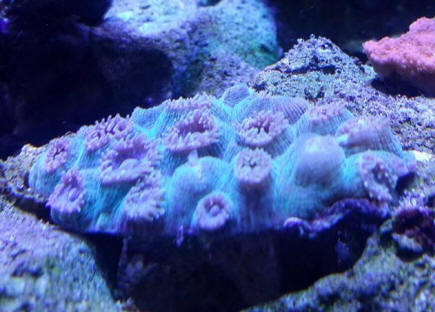 |
|
trying to ID a coral 1/30/14
Greetings! I am really enjoying this site. I have a 65 gal
tank with a 20 sump. There is liverock and sand. I recently bought
another small piece of live rock I thought had dead coral on it. I'm
thinking it might still be alive! I am trying to figure out what
exactly it is I have and how to take care of it. I have showed a few LFS
staff the attached picture and they think it's a sun cup?
<Likely a Dendrophylliid; though some of the Caryophylliids could be
considered>
I guess I'm not sold on it because of the coloring and spacing between
tubes. I've looked through pictures on this site and see possibilities
of Goniopora and Dendrophyllildae( black tube)?. What do you think? I'm
very excited because I'm wanting to branch out and try some low light
corals and macroalgae to spruce up my tank.
Thanks! Tracy
<See the pix of both families on WWM. Bob Fenner>
|
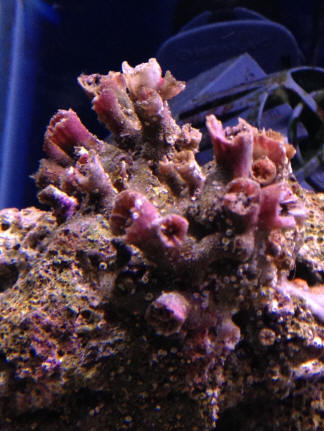 |
|
LR Hitchhikers in QT - OK to transfer to FOWLR display? and
engineer gobies 6/1/13
Bob,
<Big D>
Based on my emailing with the Engineers, I've decided to transfer all life
from my smaller tank to my display tank. Why not combine households...
<Mmm, well, the Lions may well inhale the shrimp>
There are a few hitchhikers I wonder if I should have worries about with
this move. They are the stinging celled specimens in the pictures (which I
am having difficulty getting a positive ID for, based on WWM and Google
pictures), and also a hairy gorilla crab.
<... the polyps... some sort of stony coral... May be a single
Caryophylliid. See WWM re>
They will move, with the engineer gobies and peppermint shrimp (aka lunch),
to my FOWLR display which has - 2 large volitans lions, a large harlequin
tusk, a medium red Coris wrasse. A Rabbitfish and trigger will be added
later.
<The Labrids will definitely consume the shrimp>
Should I worry that these hitchhikers will threaten my fish or otherwise
become nuisances?
<Mmm, no. BobF>
Thanks for your opinion, Dave
|
.jpg) |
|
Can you identify this little guy/girl ( of course you can
;-) ) 3/20/13
Hey Guys,
<Matt>
I thought it was now my time to probe your apparently un-exhaustive
knowledge bank. I got the (beautiful) picture of a rather cool little
guy that I found on my live rock.
<Very nice>
The rock has been in my aquarium for over a year, but I didn't find him
(or her) until I moved all the live rock to a new 180 gallon tank. I
really like it, but I am a little afraid that it could be
some sort of aphasia,
<I forget... Heeeeee! Aiptasia>
which I will have to kill off. If it is not a pest I don't want to harm
it because I think it is really cool.
<Not a pest; well not much of one>
I have seen some other pictures on your site, and you identified them as
a non-photosynthetic stony coral, but I just wanted to be 100% sure, and
I figured you could use the picture as it seems to be a little clearer
than some of the other
pictures of similar creatures on the site.
Thanks
Matt
<Is there a stony skeleton here? If so, then this is likely a single
polyp Caryo/Euphylliid of some sort, perhaps a Dendrophylliid colony
starter. Bob Fenner>
|
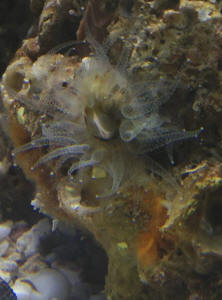 |
|
Interesting Cnidaria, ID 11/30/12
Dear Crew,
<Bryce>
There are two of these that have been in my tank for at least six months
now,
<Recruits>
and have grown considerably. At first they looked like Zoanthids.
<Mmm; am putting my bet that this is a type/species of Euphyllia:
http://www.wetwebmedia.com/caryoeuph2.htm
However, this one is about 1.5cm in diameter now and very clearly not a
Zoanthid. I also considered Aiptasia about three months ago, however they
are not spreading like Aiptasia do. I also think they must be
photosynthetic,
<Me too>
due to the pink coloration; that said I have also been feeding it some
Mysis shrimp. I am quite fond of them, please don't tell me that they are
going to be a problem. Also, I am not talking about the Favites Brain that
is also visible in the picture. I went through all of the Stony Coral ID
faqs and couldn't find any corals that looked similar.
Now, if you promise not to laugh at me, I was wondering if it was a
Dendrophylliid? The only other thing I could think of was Euphylliid,
<Ah yes>
but I have never done well with species from this genus for some reason (I
gave up after a frag, and torch perished). I really appreciate the work you
all do.
Bryce
<Thanks for sharing. Bob Fenner>
|
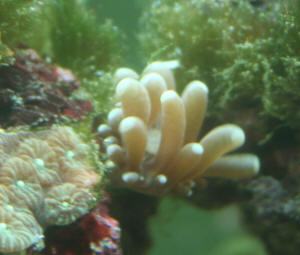 |
|
LPS ID
6/5/12
Hello, I am having a little issue identifying this LPS I got 3 days ago.
The previous owner insists that he got it from a reputable online site
(he never said which one which makes me wonder) and is trying to
convince me that it is called an "Aussie Neon center Lobo". From all of
the pictures I have seen of Lobos, this one just doesn't quite seem
right. Other than a Lobo, I figured it might be a candy cane coral. It
looks an awfully like
one. But at the same time it doesn't. It seems too inflated during the
day (Second pic. Has a mark on the top left from accidentally getting
stung by my Torch coral... oops), much like a Lobo, and at night it
opens up REALLY wide and sends out short and long sweeper tentacles
(First Pic)! Not quite like any candy cane that I have ever seen. I keep
jumping back and forth guessing if it is a Lobo or a Candy cane. It even
has some people on a forum I am on stumped. Could it possibly be
something else maybe? Acan maybe? I need a much more experienced eye to
ID this for me I think.
Thanks! LPS IDView photos Download all You are invited
to view Holly's album. This album has 2 files.
Holly, please give us an actual link to the album or attach the photos
to your email. Using your information leads to Buddy Holly's
record albums.
James (Salty Dog)
Re: LPS ID
Oh, I am sorry about that. I thought I attached the pictures. Here they
are.
LPS ID – 6/6/12
> Hello, I am having a little issue identifying this LPS I got 3 days
ago.
> The previous owner insists that he got it from a reputable online site
(he > never said which one which makes me wonder) and is trying to
convince me
> that it is called an "Aussie Neon center Lobo".
<Mmm, maybe Lobophyllia sp.:
http://www.wetwebmedia.com/mussids3.htm
From all of the pictures I
> have seen of Lobos, this one just doesn't quite seem right. Other than
a
> Lobo, I figured it might be a candy cane coral. It looks an awfully
like
> one. But at the same time it doesn't. It seems too inflated during the
day
> (Second pic. Has a mark on the top left from accidentally getting
stung by
> my Torch coral... oops), much like a Lobo, and at night it opens up
REALLY
> wide and sends out short and long sweeper tentacles (First Pic)!
<The one w/ the long tentacles looks like a Phyllangia (P. mouchezzi?)
to me>
Not quite like any candy cane that I have ever seen. I keep jumping back
and forth
> guessing if it is a Lobo or a Candy cane. It even has some people on a
> forum I am on stumped. Could it possibly be something else maybe? Acan
> maybe? I need a much more experienced eye to ID this for me I think.
> Thanks!
<All guesses are tentative... Bob Fenner>
Query
Bob,
I put a query in your inbox to get your input. I believe this is a
Lobo species of some type but not positive on this.
<Have Bcc'd you on my resp.>
There are so many colors and shapes that it's hard to pin point, at least
for me anyway.
Thanks,
James
<Thank you, BobF>
Re: LPS ID – 6/6/12
Thanks Bob.
James
<Thank you James. B>
|
[1].jpg)
[1].jpg) |
Not your top priority. Scientific naming,
credits 1/21/12
Dear WWM (hopefully Bob),
This does not have to do with my tank or animals. Instead I was
wondering who first described Euphyllia ancora?
<Mmm, yes: Vernon and Pichon in 1980... The convention for
scientific naming includes placing the original "namers" of
scientifically described species after their binomial names... and the
date of the recording in recognized literature... and placing the last
two in brackets if the species has been subsequently moved to another
genus.
See here re this one: http://www.wetwebmedia.com/caryophyllids.htm>
So, what initial or name
would go after the name if it were to be printed in a scientific
document.
<As above>
In my bio. class I have to put together some of the scientific names of
some species and I chose corals. Thanks.
Bryce
<With some searching, perhaps the help of a large (college likely)
library, reference librarian, you/one can look up/find the original
description of all species. Bob Fenner>
|
Coral identification 1/21/12
Hello, I bought this from my lfs & they had a few that I
think were frags.
<?>
I got the smallest for £20 about 6 months ago I think
& it has tripled in size but I can't remember what it is,
can you please enlighten me as I wanted a hammer head &
thought this was one but am confused because the heads don't
look very...
<Is a Euphyllia sp.>
Well hammery! Seems happy & healthy & opens up every day
for our visual enjoyment. Pretty sure its a LPS but just wanted
some clarification. Thanks in advance. Will Bailey
<Please read here: http://www.wetwebmedia.com/caryophyllids.htm
Bob Fenner>
|
|
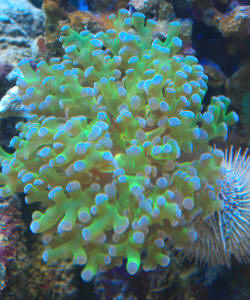
|
|
Help in coral identification -
10/22/10
Hi there,
<Howdy>
Recently got a coral from the LFS who said it was a Fox
coral,
<Nemanzophyllia, N. turbida...>
but deflated because of shipping.
<Mmm, does happen>
Read that these are the grumpiest of corals
<?>
and even if you fart in the same room they will deflate for days.
Had read that they are good beginner corals and also not
aggressive at all. Have placed it by the side of a clam and it
still is deflated. Wanted to know whether it is actually a fox
coral
<Appears to be, but bleached...>
or some type of open brain coral. There are small pin point
mouths on the valleys and the skeleton on the sides is fine and
needlelike. No visible tentacles are observed. Just help me out
on the identification.
Cheers,
Vijay.
<And you, Bob Fenner>
|
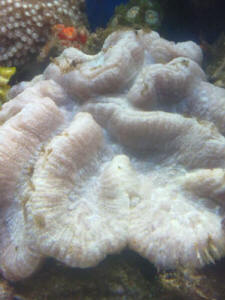 |
|
Anemone ID 7/22/10
HEY WWM!!!!
So me and my girlfriend got into a dispute about the ID of this
frag we purchased today. Is it possible to clear up our confusion
and positive ID from this photo? It is florescent and able to
recede.
Thank you,
M & L
<Mmm, could be a Euphyllia sp., but most likely an Anemonia
majano. Bob Fenner>
|
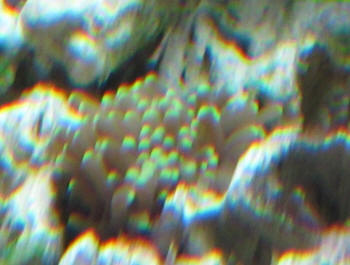 |
|
Re: Anemone ID 7/24/10
I guess the image is not very good. It doesn't really look
like any majano or images of it that I have ever seen. It likes
to extend during the day time and extends to about double the
size in the image. There is a
skeletal cup
<Oh! Then scratch Anemonia/Actinarians period... I'll
default to my "B" choice... This is likely Euphyllia
glabrescens... See here:
http://wetwebmedia.com/caryoeuph2.htm
or on the Net...>
that they recede into during the night time, and the florescent
colors are very vivid. There does not seem to be a mouth in the
middle. I thought that it was Euphyllia Glabrescens,
<Oh! I do agree>
my girlfriend thinks it is some kind of bubble tip.
<... not Entacmaea... Anemones don't have hard skeletal
parts>
Is there a distinct way to differentiate between the three
options? Also could it be a lavender mushroom?
<Doubtful>
There are some images of it that look strikingly similar as
well.
<BobF>
|
Frustration in the researching world, Euphylliids...
species/common names (ID), and lighting/systems 6/1/10
Hello!
<Richard>
Firstly I must state that your site, and thus all the hard working
individuals at said site, are a fantastic staple to the marine hobby as
a whole'¦ thank you.
<Welcome>
I am hoping that you will be tolerant of yet another lighting
question/issue. I have been deliberating the vast supply of opinions on
the web, at various LFS, and libraries, and find more confusion then
answers. While the issue encompasses all manner of critters, I will
restrict my scope to the latest confusion. Specifically: the Torch
Coral.
<Euphyllia sp.>
While most sites differentiate between the Torch and argumentatively,
the Frogspawn (aka. Octobubble), many sites state that one is the
common name for the other.
<Such is the fate of common appellations>
As you can well imagine, the information offered also conflicts.
Lighting is ranged at literally all levels from low/sheltered to
med-high and high levels.
<I have encountered these species in a wide range of light
intensities, hence qualities in the wild and captivity>
More then one site state within the description area, that 'In
nature they are commonly found in reef slopes in large colonies,
<This is so in many areas>
deeper than most other LPS corals'
<Also>
and also that it 'requires moderate to high intensity indirect
lighting' then in the quick stats area 'Lighting: Medium'.
Unfortunately, a substantial number of other sites state many, all, or
contradictory points regarding this same category.
I believe in researching all new inhabitants to my system, (a lesson
learnt from you), but am at a loss most times as to how one is to
(paraphrasing here) 'not take any one person's opinion, but
gather from multiple sources' as you have -- and I believe wisely
-- suggested at various times.
<Yes>
I believe I have mixed the issues. One: are the Frogspawn and the torch
coral actually the same beastie?
<There are two species>
Two: What are the true stats regarding origin and placement/condition
requirements of a Torch Coral (and/or are they the same as the
Frogspawn)?
<Torches are encountered much more frequently in shallow water (less
than ten meters) depths, and brighter light conditions, but both can be
photoacclimated to lower lighting in captivity>
And three: do you have any links to reputable sites where one could
find pertinent information on this and/or other corals?
<ASIRA, ReefBuilders and Jake Adams' ReefStock if you can get it
to come up...>
The last thing I want to do is cause unnecessary loss to this hobby
through negligence. And while I know that the entire crew at WWM
support this viewpoint, I cannot help wondering why it appears that so
many others do not'¦
<Mmmm... the present state of the Net, human
foibles/conditions...>
if they did, perhaps there would be less conflicting data out there due
to due-diligence on their part.
This was not intended as a rant, please feel free to edit as you see
fit. But please understand I do appreciate any patience and assistance
you can offer.
Richard J.C.
<Thank you for your honest, carefully worded message/sharing. Bob
Fenner>
*Frustration in the researching world, Euphylliids...
species/common names (ID), and lighting/systems 6/1/10 SaraM input*
6/2/10
Hello!
<Richard>
Firstly I must state that your site, and thus all the hard working
individuals at said site, are a fantastic staple to the marine hobby as
a whole'¦ thank you.
<Welcome>
I am hoping that you will be tolerant of yet another lighting
question/issue. I have been deliberating the vast supply of opinions on
the web, at various LFS, and libraries, and find more confusion then
answers.
While the issue encompasses all manner of critters, I will restrict my
scope to the latest confusion. Specifically: the Torch Coral.
<Euphyllia sp.>
While most sites differentiate between the Torch and argumentatively,
the Frogspawn (aka. Octobubble), many sites state that one is the
common name for the other.
<Such is the fate of common appellations>
As you can well imagine, the information offered also conflicts.
Lighting is ranged at literally all levels from low/sheltered to
med-high and high levels.
<I have encountered these species in a wide range of light
intensities, hence qualities in the wild and captivity>
<<Indeed, I think this might be why we see such a wide range of
lighting tolerances and intolerances of these corals in captivity.
I've seen them apparently doing well under just about every kind of
lighting from very modest lighting as well as the highest intensity
metal halides.>>
More then one site state within the description area, that 'In
nature they are commonly found in reef slopes in large colonies,
<This is so in many areas>
deeper than most other LPS corals'
<Also>
and also that it 'requires moderate to high intensity indirect
lighting' then in the quick stats area 'Lighting: Medium'.
Unfortunately, a substantial number of other sites state many, all, or
contradictory points regarding this same category.
<<It's funny, but, one of the many "stupid" things
I did when I set up my first marine aquarium was that I hung my metal
halide light at an angle to the surface of the water. My thinking was
that that was some how more "natural." People made fun of me
(I even made fun of myself), but you know... there might have been
something advantageous about hanging the light that way. My LPS tended
to do fairly well until I started tinkering with stuff... maybe I
should have just left well enough alone.>>
I believe in researching all new inhabitants to my system, (a lesson
learnt from you), but am at a loss most times as to how one is to
(paraphrasing here) 'not take any one person's opinion, but
gather from multiple sources' as you have -- and I believe wisely
-- suggested at various times.
<Yes>
I believe I have mixed the issues. One: are the Frogspawn and the torch
coral actually the same beastie?
<There are two species>
Two: What are the true stats regarding origin and placement/condition
requirements of a Torch Coral (and/or are they the same as the
Frogspawn)?
<Torches are encountered much more frequently in shallow water (less
than ten meters) depths, and brighter light conditions, but both can be
photoacclimated to lower lighting in captivity>
<<Since we never know for sure where the coral originally came
from, I like to advice people to try and obtain cultured/fragged corals
that have been around in captivity for awhile. Of, even if it's not
a frag, just any colony that's been hanging out in an aquarium long
enough to have been successfully acclimated already. It seems that a
lot of corals don't survive the initial acclimation to captivity,
much less a second acclimation into our home systems. I think of it a
bit like "un-natural selection"... some of the new-arrivals
die off immediately, some a little later... the ones that hang in there
for months after arrival seem to be the most suited for aquarium life.
Thus, I always sought the corals knew had been in a LFS
(or someone's home aquarium) for a long time.>>
And three: do you have any links to reputable sites where one could
find pertinent information on this and/or other corals?
<ASIRA, ReefBuilders and Jake Adams' ReefStock if you can get it
to come up...>
The last thing I want to do is cause unnecessary loss to this hobby
through negligence. And while I know that the entire crew at WWM
support this viewpoint, I cannot help wondering why it appears that so
many others do not'¦
<Mmmm... the present state of the Net, human
foibles/conditions...>
<<Well, I know in my case, when I first started out, I found a
lot of conflicting information and bad information. I thought I was
being responsible, but the problem is that there's no one
"authoritative" source in this hobby (not one that everyone
follows and refers too). Bob's book probably comes the closest to
such a thing... and that's what I personally read first. But then
you start to read other stuff and hear other people's opinions and
next thing you know you don't know what you're supposed to be
doing anymore. Unfortunately, most of us in this hobby, the ones who
last more than 6 months to a year... in the end, we still learn mostly
by trial and error.>>
if they did, perhaps there would be less conflicting data out there due
to due-diligence on their part.
This was not intended as a rant, please feel free to edit as you see
fit.
But please understand I do appreciate any patience and assistance you
can offer.
Richard J.C.
<Thank you for your honest, carefully worded message/sharing. Bob
Fenner>
<<And yet... somehow I doubt even all the irresponsible aquarists
in the country put together are doing as much damage as the oil leak
presently marinating the gulf right now...>>
<<Best,
Sara M.>>
|
Coral ID 3/21/10
Hello Crew,
Hope you are all well!
<... 16 plus megs of pix... No searching... Idiocy>
wonder if you would be able to help me with a coral ID. I bought
this beauty a few months ago - it was sold as a Euphyllia, which
I think it may very well be...or at least some sort of
'Phyllia'.
It is not, to my eye, a Torch, Hammer, Frogspawn, Duncan,
Elegance, or any of the usual 'Phyllia' corals.
<E. glabrescens>
It is most reminiscent to me of a Duncan, with different
colouring (almost typical Torch colouring), but its skeleton is
more truncated and compact.
It has maybe 20 heads but they do not branch the way that a
Duncan/Torch etc do, and the tentacles somehow seem more
uniform.
As you can see, my clowns love it, and it loves its position high
in the tank under halides, directly in the water flow. Any
suggestions happily received!
Thanks and keep up the good work,
Lisa
<Read here: http://wetwebmedia.com/caryoeuph2.htm
and the linked files above. Bob Fenner>
|
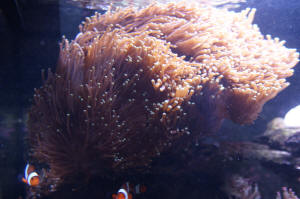 |
re: Coral ID 3/21/10
Hi Bob,
I apologise for my idiocy.
<Oh?>
This is not Euphyllia glabrescens. I have had many in the past
and the skeleton is entirely different to what I currently
have.
<You can see the skeleton? Can you send along an image of
this? Phaceloid? Meandroid? You have close up pix of the
corallites?>
I have spent several weeks researching this and looking through
the site and have not found this coral.
Sorry to have bothered you.
<My bet/guess is still on this Euphylliid... Please comply w/
our request going forward to limit file/image sizes to a few
hundred Kbytes per. BobF>
Re: Coral ID 3/21/10
Hello,
My only sight of the skeleton has been on moving the coral into
its current position - polyps do not retract readily at night;
however I will try to secure a (smaller) photo for you if it is
of interest.
<Up to you>
Skeletally, yes - phaceloid (most definitely not
meandroid/flabellomeandroid). Not the thin-septa'ed branching
form that I have often seen E. glabrescens take, however. This
individual has extremely tightly packed corallites, around 1.5 cm
in diameter - perhaps 0.5 cm between each corallite - which are
uniformly distributed, and which all extend perhaps 4 cm from the
rock base, over an area of perhaps 10 cm x 20 cm. The uniformity
of this coral is what has intrigued me.
<Does sound strange... there are other Scleractinian/families
that macroscopically look like this... but they are exceedingly
rare in the trade>
Another point, albeit minor, to mention is the tentacles - to me
they lack the slight bulbosity to the tip that I have always seen
with E. glabrescens. Might be nothing....
Will get back to you ASAP.
Thanks, Lisa
<And you, BobF>
|
|
Re: Another hitchhiker ID please 10/10/09
Hi crew!
<Hello Nicki>
Just thought I would send some updated pics on our 2 mystery
guests. They are both growing and getting bigger.
<Thank you for sharing with us, very nice pics.>
Thanks,
<You're welcome. James (Salty Dog)>
Nicki
|
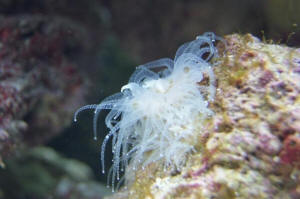 [1].JPG) |
|
I.D. Please, Euphylliid 9/17/09
Hello, Crew
I am wondering if someone can I.D. this (coral/anemone ?) here in
the attached photo's.
It grew on the skeleton of a pearl bubble tip coral, but on the
outside .
It has one boney disk and one fleshy mouth . Will eat daily,
meaty foods, so I feed it
every other day. Is it an anemone or a coral ? I'm confused
!
Thanks for any input you can give me.
Karrie
<Does appear to be a regenerating Plerogyra or Physogyra... Is
a Scleractinian... Coming back from seeming oblivion in your good
care.
Bob Fenner>
|
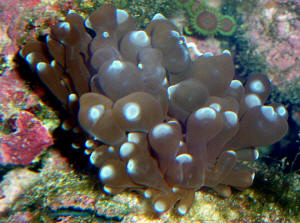 |
|
Anemone, What Is It 6/21/09
Hi I have 3 small clear Anemones. I have not been able to ID
them. Attached is a pic of them. Could you let me know what they
might be. Are the Bad or good Anemones?
<Appears to be a species of Glass Anemone, not desirable. See
re here.
http://www.wetwebmedia.com/marine/inverts/index.htm Scroll
down... to Aiptasia...>
Thanks
<You're welcome. James (Salty Dog)>
<<Time for new spectacles James... see the skeletons
underneath? This is a solitary Caryophylliid... RMF>>
Dan
|
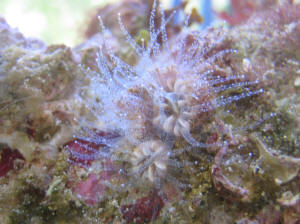 |
|
Coral Identification... Euphyllia paradivisa
5/30/2009
Hello,
<Hi there Charles, Mich here.>
I was wondering if you could help me ID this coral?
<I will certainly try!>
It was sold to me as a frogspawn that was doing poorly in the
tank it was in.
<Looks to be.>
I have had the piece almost 6 months now and it is healthy.
<Looks pretty good to me.>
Since then I have been told that it is Euphyllia cristata, but it
does not look like any photos I have ever seen of Euphyllia
cristata.
<Is a Euphyllia paradivisa from the photo and your reports of
separate heads.>
When closed it does look like a frogspawn with 5 separate
heads
Thanks,
<Welcome, Mich>
Charles
|
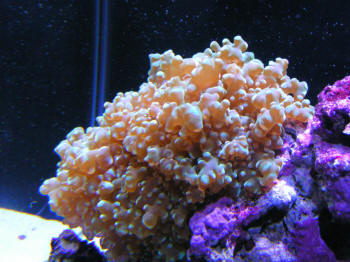 |
|
Strange White Growth. Baby Anemones?/ Anemone ID
5/30/09
Hello, and thank you for taking the time to read this!
<Hello, and you're welcome.>
We have a 55gal SW aquarium which has been set up for about 4
months now. We use a wet/dry sump filter, and have a small fuge
growing some macro algae (for the 'pods). We have a 2-4 inch
substrate bed and about 40 lbs of live rock. Our inhabitants are
2 Sebae clowns who share a Long Tentacle Anemone, 1 Midas Blenny,
2 black Mollies (left over from cycling), 1 Red Dragonette (seen
in pic 2), and 1 Mandarin Dragonette as well as various snails
and crabs. We have some different corals, a few small feather
dusters (hitch hikers) and a big orange sponge. About a month
after the aquarium was set up, I noticed a very small white
growth on one of the live rocks and upon inspection, found that
it had tentacles. Being brand new to salt-water (in the house
anyway), my first thought was a baby anemone. So, I have left the
thing alone and watched it grow until a few weeks ago when I was
asking someone about it (by my description, no pics), and they
said it might be Aiptasia, and I needed to kill it. Looking back,
I think that the person was wrong about this particular growth,
but I did find and kill some Aiptasia using Aiptasia-X. I had
applied this compound to the little white critters (by this time,
1 had turned into 3), and they looked dead until about 5-6 days
ago. Now the original one looks like I never harmed it, and the
two little ones behind it are starting to look alive as well. I
have scoured the internet, read every fish related archive known
to man, and followed up on every hunch that anyone has indicated,
and I can not seem to positively identify these things. If they
are not harmful, I would like to continue to watch them grow, and
even nourish them if possible. I think they're really cool
looking, and if they will grow to a decent size, that would be
incredible. I have no idea where they came from! Would you please
help me? Attached are two pics. I have more if these two are not
clear enough or anything. Please let me know.
<The pics do not have too much detail, but first impression
appears to be the Glass Anemone (Aiptasia). There are six or
seven species of this pest and may be the reason the pics you are
finding do not match exactly. The fact that one had turned into
three in a very short time is a good indicator that these are
likely Aiptasia.
Have you read here and related articles/FAQ's.
http://www.wetwebmedia.com/marine/inverts/cnidaria/anthozoa/aiptasia/aiptasia.htm>
Thank you!
<You're welcome. James (Salty Dog)>
-Confused/Concerned
Daive
<<James, no! The stony skeleton of this animal is clearly
visible... This is a Scleractinian... likely a solitary polyp
Caryophylliid sp. RMF>>
|
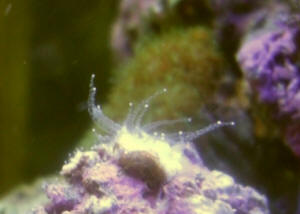 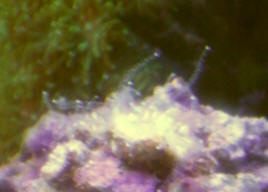 |
|
Aiptasia? Please Tell Me It Isn't So! --
03/22/09
Hi there.
<<Hello>>
I hope everyone there is having a great weekend so far.
<<Can only speak for myself but yes, not so bad>>
I absolutely love WWM and have found it extremely helpful.
<<Ahh'¦is redeeming to know>>
I was looking in my tank tonight and noticed these creatures. The
first thing that popped into my head was Ahhh no is this the
dreaded Aiptasia?
<<Hmm'¦looking at the picture, I'm not
sure>>
I just started my tank about 5 weeks or so ago and have been
working on getting the stuff together slowly. I only have around
20 lbs. of live rock that I purchased from my LFS. There are
around 5 or 6 of these on the rock so far. I looked at as many
pictures as I could in the archives and in books. From what I
have seen there are tons of different Aiptasia "types"
and couldn't find the exact picture of mine.
<<The photo provided is not really close enough or sharp
enough for me to tell for sure. These 'could' be Aiptasia
but I don't think so. They could also be Anemonia Majano, or
a Hydroid; which some folks consider to be a worse scourge than
Aiptasia (try some keyword searches on those names and see what
you think). But to me, these polyps look to be Scleractinian
rather than Actinarian (hard corals vs. anemones/similar animals)
as it appears there is a 'skeletal structure' surrounding
each (or maybe it's just the photo). I'll ask Bob to
comment re if he sees this>>
<Mmm, is a Scleractinian... perhaps solitary Caryophylliid...
I'd leave alone.RMF>
I was sort of hoping it would be something else like possibly
some sort of worm?
<<Not a worm'¦but quite possibly a
'desirable' hitchhiker>>
I fear I am wrong though and wanted an expert opinion.
<<I can't be sure without a better resolved close-up
photo>>
I thought I had taken precautions against these pests.
<<These may not be the 'pest' you
fear'¦though it is essentially impossible to keep
Aiptasia from eventually showing up in a system, in my opinion.
Best to be vigilant'¦and to have a plan>>
I have 3 peppermint shrimp, and some red legged hermits,
apparently mine don't eat these so hopefully it will be
ok?
<<I have always found such 'biological controls'
for Aiptasia to be unreliable and of little use. For
Aiptasia/pest anemone control I very much recommend the use of
Red Sea's Aiptasia-X>>
I have read emerald crabs eat these too.
<<Not in my experience>>
Maybe I'll be buying one of those?
<<The money will be better spent on the
Aiptasia-X>>
I planned on changing my CC substrate to a DSB in the morning but
now am unsure of what to do. I read a lot of posts where people
get these epidemics and can't seem to get rid of them.
<<Based on the photo, you hardly have an
epidemic>>
Should I remove the rock and let everything die off and never buy
rock from this LFS again?
<<Mmm, no'¦a bit drastic and unnecessary in my
opinion>>
Please tell me it isn't Aiptasia.
<<Can't say for sure. Get a bottle of the Aiptasia-X
and if they continue to spread or if it just makes you feel
better, you can get rid of them. Otherwise, I would be inclined
to watch/enjoy them for a while and see what develops>>
Thank you very much for your time and help.
<<Quite welcome>>
I don't have any friends in this hobby yet and don't
trust the guys at my LFS after selling me the CC substrate and
now this ugh.
<<The local fish stores (or anyone for that matter)
don't always have all the right answers or provide the
'best' advice'¦and don't forget they also
need to make a buck. Some stores are certainly better than
others, but regardless of which is available to you; do your
research ahead of time and learn to rely upon yourself and your
own good judgment>>
Thanks again.
Roman
<<Regards, EricR>>
<NOT Aiptasia... RMF>
|
 |
Bubble Coral: Physogyra and Plerogyra 1/27/2009 Hi
wet wise crew. <Hi Kai, you are also a wet one! I'm sure you
know, Kai means sea in Hawaiian, is a very nice name! Mich with you
today.> Have a query about bubble coral today. I have 2 bubble
corals in my tank, one is green while the other is kind of a pale
pinkish white colour. The green bubble coral opens up very nicely and
the bubbles look plump and taut. The other one however, has smaller and
much more bubbles. Are they of a different species? <Quite
possibly.> I am starting to think that the lighter coloured one is a
pearl bubble coral, Physogyra spp. <Very well could be from the
sounds of it.> How do I differentiate the 2, if they are indeed
different? <Could probably be done visually. An example of the two
different genera here: Physogyra lichtensteini: http://www.wetwebmedia.com/dwfangselfaqs.htm
Plerogyra sinuosa: http://www.advancedaquarist.com/2005/7/aquarium_album/plerogyra.jpg
> If the one with the smaller bubble is not Physogyra, and instead,
the normal big bubbled one, is it a problem that the bubbles are small
and numerous? <Not likely, but I do suspect that you have two
different genera.> Thanks for the help <Welcome!> Regards -
Kai <Cheers, Mich>
Bubble coral 02/08/09 Hi Mich, thanks for the reply
:) Yes, I am rather wet...judging by how unhappy my bed is every
morning. Omg, lol I was joking. Thanks for the links, I have concluded
that my two bubble corals are indeed different species. The smaller one
has weird and odd shaped bubbles...unlike the normal one. <It's
best not to get in the habit of judging/determining species by the soft
tissue. You'd likely have to look at the exposed skeletons of these
corals to know for sure what species they are, if different or the same
species.> I'm pretty sure its a pearl bubble coral. Oh....my fox
coral got toppled by my turbo snail, and a small 0.5cm piece of
skeleton broke off, tearing away some meat with it. What are the
chances of recovery? <If the coral is otherwise in good health, it
should recover just fine.> I have placed it in an area with moderate
flow to wash and clean the wound. Also, I purchased a torch coral and a
hammer coral 3 days ago. The hammer coral is opening up really
beautifully, but my torch coral has only opened up about 30% of its
potential... I figured both will take about the same time to open up as
both are from the same family, but it does not look like it. I am quite
worried for my torch. Any idea why it is not opening up? Perhaps 3 days
is a little too soon as it may need more time to get used to my tank?
<Possibly, yes.> I am just quite confused as my hammer coral took
only 1 day to open up 100% <No need to be confused, different corals
behave differently. Yikai, you seem very interested about all these
corals. Let that interest/passion drive you to read as much as you
can... and learn the scientific classifications of these corals, some
of the science/theory behind these things.> Thanks for the prompt
reply Mich. <Sara M. here this time, helping.> Hope you have a
great Chinese new year :) (we are celebrating it here in Singapore),
and happy year of the ox! Regards - The wet one <Cheers, Sara
M.>
Is this a bubble coral? 8/19/07 Hi again
Crew, <Hello Agnes, Mich here.> I have always thought that
this is a bubble coral and the bubbles do look like it. But all of
the pictures I see online of bubble corals don't have the flat
middle showing just a cluster of bubbles that look like a bunch of
balloons. Sometimes mine opens up about 4" to 5" across
and looks just so pretty. I would like to know for sure what it is.
I'm sorry I said that, I know it's really hard sometimes to
be "sure" of anything in a marine tank. <Yes, you are
correct it is a bubble coral (Plerogyra sinuosa). The flat middle
is normal, though not always as visible as yours appears to be.
Nothing to worry about here.> Thanks for your help again.
<Welcome!>
Agnes |
|
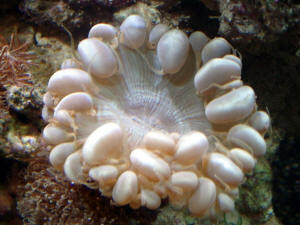
|
Coral identification, Torch Coral (Euphyllia
glabrescens). 2/20/07 Good morning guys, <Hello Steve, Mich
here.> I want to start by saying what a great site you have.
<Thank you for your kind words.> I have been in the hobby
about 9 years and have learned more in the few months since finding
your site then the years of trial and error on my own. <Often
the case.> I recently received a new coral for my birthday
(picture attached). <Happy Birthday!> My wife purchased this
coral for me and was not sure of the name. I am trying to find out
what kind of coral this is. The structure of the polyps looks
almost star-like. Once I get an identity some info about feeding,
water flow, and placement. <I believe you were given a torch
coral (Euphyllia glabrescens). These corals are typically found in
somewhat turbid location, and do well with a gentle current and
bright indirect light. Be aware of the sweeper tentacles, they can
give quite a sting to any nearby corals and possibly even you! I
typically get blisters from this genus. More here: http://www.wetwebmedia.com/caryophyllids.htm http://www.wetwebmedia.com/caryoeuph2.htm > My set up
is a 75 gal DAS tank about 75 lbs live rock, built in skimmer. The
sand bed is less than 1/2 inch. I have two 175 W metal halide
lights with 2x 96W actinic lights. I have the actinic lights on
from 9:00 am to 9 pm with the halide's coming on at 11:00 am to
7:00 pm. Also a little natural light hits the tank from 6:00-8:00
am. The lights are placed about 12 inches from the water. Currently
this coral is placed at the top of the tank about 6 in from the
top. He is right in the middle so not directly under the halides.
<I think this may be too high. I would be concerned about light
shock. It is better to start most any coral low and gradually move
the coral closer to the lights to prevent photostress. More here:
http://www.wetwebmedia.com/acclimcoralslight.htm > He
does seem happy sweeper tentacles coming out often. I was not able
to quarantine this coral since I took down my quarantine tank a few
weeks ago to start a small tank for my daughter. I also didn't
plan on adding any more corals or fish so I was not thinking this
would be a problem. <Always good to have a QT on hand even if
it's just a Rubbermaid type container, heater and filter.> I
have been feeding DT's phytoplankton, as well as baby brine
shrimp. <Watch the DT's can kick up the Nitrates.> Other
tank mates are orange Tubastrea (feeding really well but getting
algae in the center) <I'd try to remove the algae, perhaps
with a turkey baster.> 1 green finger leather, <Torch should
be placed away from the Sinularia.> colt coral, Lobophyllia,
Wellsophyllia, and Montipora peltiformis. Fish are 1 regal tang,
<I do wish your tank was bigger for this fish. Usually recommend
a 100 gallons at a minimum for regal tang (Paracanthurus
hepatus).> 1 clown, and 1 Lyretail Anthias. I was worried about
the high placement but due to the brain corals I didn't want to
place too close to the new one. <Yes, the torch can pack a
powerful punch.> Lastly the only dosing I do is with iodine, and
liquid gold pro. My calcium is a little high, it's about 510.
<Too high under 400 is better.> I have not dosed any calcium
in months but it has not lowered. <How's your
alkalinity?> Thanks for your help please let me know if you need
any more info. <You're welcome. -Mich> Regards,
Steve |
|
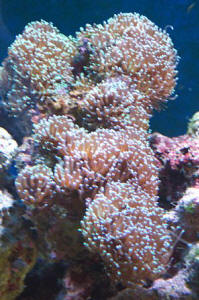
|
| Bubble Coral? I D help. 2/22/06 Hello guys! I looked
through the site and cant seem to find a bubble coral that looks
like this one. Instead of the round polyps like my other (Plerogyra
sinuosa) bubble coral, this one has very odd shaped polyps (see
pictures). <Yep... looks like Physogyra... see here: http://www.wetwebmedia.com/caryoeuph2.htm> Also,
instead of one big mouth, this one seems to have several small
mouths when the polyps contract at night. <Yepster> Other
than that, it has the same sweeper tentacles at night, and
looks/acts the same as my other bubble coral. I'm just curious
why it has the smaller mouths and odd shapes polyps. Also it is
branched, I didn't know bubbles did that. It has a main
skeleton that splits in two like a tree, with a separate coral on
each head. Thank you very much for any help!! (And when is
Conscientious Marine Aquarist 2 coming out!!??) Eric <Heee! Hope
to be working on some other titles ahead... Be chatting, Bob
Fenner> |
|
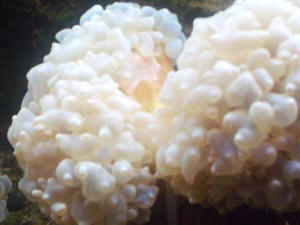
|
| Coral I.D. 9/29/05 Hi! WWM Gang, Rich Wilson here,
<Howdy Rich.> Sending you a picture to see if you can ID
these 3 singular corals. I have had them about 6 month's, they
look similar to a Grape or Frog spawn, they are open all day when
the lights are on, and continually wave about, (might be due to
water movement) they are approx 1" tall & 2" in
diameter, deep pink at the base. I have looked just about
everywhere to ID them, the only coral like it that I can find in my
books and on the WWM coral ID is the Grape & Frog spawn.
<Looks like you identified it correctly. Its definitely a
Euphyllia, I cant really tell the exact species whether it be a
torch, frogspawn or branching hammer. I trust your judgment though
and at any rate care is about the same for most of the coral in
this family.> Regards, Rich W <No problem. Adam J.> <
http://photos.msn.com/Viewing/Album.aspx?PST=8nK2AN1B!1Lc0GYplxDie
Cvw92t*ASJd*UxWfvs7XZ*Zdo9vopUW5kqbh7V!1aN*5QaiI7NsxE2dUiDhKsJUjw%24%24> |
|

|
| Coral ID 10/21/05 Good morning, to whom ever I get a
hold of. I recently purchased this frag for two dollars at my LFS.
They did not know what it was (the fish/coral mgr. was off) I was
helped by the woman who sells rodents. It has purple bubbles and
little feeding tentacles Can anyone ID this for me? Thanks in
advance, Lucas <Mmm, looks to be a Euphyllia species to me.
Please see here: http://wetwebmedia.com/caryidfaqs.htm
Bob Fenner> |
| Euphyllia sp. 10/19/05 Good morning, to whomever I get
hold of. I recently purchased this frag for two dollars at my LFS.
They did not know what it was (the fish/coral mgr. was off) I was
helped by the woman who sells rodents. It has purple bubbles and
little feeding tentacles Can anyone ID this for me? Thanks in
advance, Lucas <Hi Lucas, it's very hard to tell what exact
species your coral is so we will simply refer to it as Euphyllia
sp. (more than likely it is a torch (E. glabrescens) or frogspawn
(E. divisa). Please provide it with moderate lighting, steady/clean
water parameters and light/moderate current. It should recover and
grow for you with proper care. Good luck Lucas! - Ali> |
|
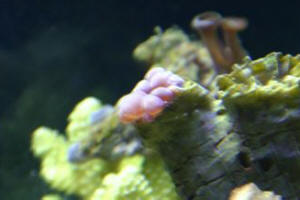
|
Euphylliid ID Pearl - Wall (Physogyra lichtensteini) what
about this what is the difference between pearl and wall pearl I cant
seem to find the one above. <Mmm, this is one species... Physogyra
lichtensteini is found in a few habitats... Bob Fenner>
Euphylliid IDs 6/29/04 Is there a difference between a branch
frogspawn and wall frogspawn? <They are different species> some
site say there the same others charge more for the all. thanks :)
<Much of the losses suffered o import are reflected in the price of
animals that survive :) Best regards! Anthony> TORCH CORAL
Happy Thanksgiving, Hi there Bob, got a question about my torch coral.
There seems to be a large bubble that has formed right in the middle of
all the polyps on the torch. I've looked everywhere trying to find
out what this might be but haven't found anything. What might this
be? <Likely nothing but the coral itself> It is the same color as
the fleshy part of the polyps. <Have seen such apparent
"growths" before... not discovered that they're anything
but some activity of the animal/colony itself Resolves on its own. Bob
Fenner> Thanks, Charlie E.
Pink Frog Spawn... ah, no 11/7/04 There is a guy that has
corals for sale on eBay and he claims to have a very rare pink frog
spawn. Have you ever heard of such a thing or does it probably not
exist? <very likely one of those ignorant or insidious vendors
selling bleached corals (pastel colors) as "rare" to the
unsuspecting> I have searched all over the web and have found no
other on pink frog spawn. Thanks, Andy <correct... does not exist in
a healthy state. Anthony>
Frogspawn or Torch coral ID I just purchased over the weekend
a coral the LFS said is a Torch Coral, however it does not look like
any of the pix I can find on the net. I'm attaching a few pix for
reference in ID. Hopefully you can let me know what I got. <<
Well the pics are very difficult to make it out. However, it looks like
a Frogspawn coral to me, which many people call Torch Corals. >>
THANKS <<torch1.jpg>> <<torch3.jpg>>
<<Leather_and_unk.jpg>> <<torch2.jpg>>
<<torch4.jpg>> The file Leather_and_unk is a pic of a
leather coral (I think) I obtained from a friend in Germany along with
the coral (unknown) in the background there-of. << Yes, a typical
Sarcophyton Leather Coral. >> Any ID on these would be great as
well! Again, Thanks-n-advance Robert Molenda << Blundell
>>
Identifying of bubble coral! Hi Tim again,
I got this bubble coral. I was told it was a cay-eye bubble coral
from the LFS. Is this correct or what's your ID on it?
<There are many common names for corals; I personally find these
common names misleading. I can think of several common names to
describe one bubble coral (Such as pearl bubble coral, Bladder
coral, Bubble coral, etc.). If you wanted the proper name for the
coral, it would be Plerogyra sinuosa (Otherwise known as the Bubble
coral, Bladder coral, Cay-Eye bubble coral, etc.) Thanks.
<No problem. Take Care, Graham.>
Cheers,
Ben |
|
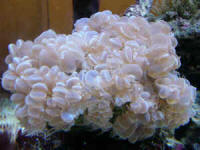
|
Coral Identity I was hoping that you could help me identify
the coral in the attached pictures. The form is similar to that of a
xenia, <not so, my friend... Xenia is a soft coral (Octocoral) and
this is a Scleractinian: Euphyllia divisa... AKA Frogspawn/Grape coral.
A stony coral (hard coral)> but the polyps, which glow green under
actinic, are more like the tentacles of an anemone, also there appears
to be a central feeding tube in the middle. <the mouth of each
polyp> The trunk feels hard and calcareous, off of which there are
three branches on which the heads sit. <the skeleton/corallum> I
appreciate any help you can give me. Thank you. Ed Ingold <this is
regarded as a large polyped stony coral and requires small weekly if
not daily feedings of finely minced foods. See here for feeding
guidelines: http://www.wetwebmedia.com/fdreefinverts.htm Best regards,
Anthony>
| Coral ID Could you please tell me the name
of this coral, along with what type of lighting you would recommend
for keeping it, and what source of food it needs if any? Thanks
<The coral pictures is commonly referred to as a Torch coral,
Euphyllia glabrescens. These corals show up best under moderate
lighting and current. Some type of fluorescent (VHO or PC) makes
their colors really come out. Somewhere about 12" from the
surface under fluorescent lighting or closer to 20" under 175
watt MH's. This, like many LPS corals, needs fed with small,
meaty zooplankton substitutes. Plankton, Mysis shrimp, and
Sweetwater Zooplankton are all good choices. Let me suggest to you
Eric Borneman's "Aquarium Corals". It is an excellent
reference. -Steven Pro> |
|

|
| Identification Please? Could you identify
this. LFS was not sure when they sold it to me as a torch. Could be
frogspawn. Please let me know your best guess. <no guess needed
for either of us: it is "Frogspawn", Euphyllia divisa.
best regards, Anthony Calfo |
|
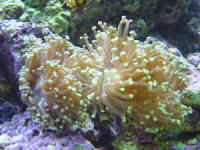
|
| Octocoral Dear Robert <Anthony Calfo in
your service> Please find attached a pic of an 'Octo'
coral that I purchased from my LFS 3 days ago. I am told it is
related to 'bubble' coral. Can you help me identify it
please? I'm sure its is from a sort of stinging celled coral
family. <yes... fair to call it a "bubble" coral. It
is the Caryophylliid, Physogyra... also commonly known as
"Pearl or Rice bubble coral"> I resides about 6"
from the surface of my water The lighting is currently 2 marine
whites 1 actinic 03 & 1 50/50. <fine indeed... is
appreciates moderate lighting...not too bright (MH are too sever
without very careful acclimation). This coral needs regular
feedings of finely minced meaty foods (large can be damaging
although ingested)> During these early days in my tank is it
normal for the stinging tentacles to be open as in the pic? My LFS
said it likes very low flow. <low to moderate...never strong
flow> Is this correct? <yes> It is currently placed
halfway across the length of my 72" tank and the outflow from
my pump is to the right of it (pointing at the coral to the right
of the pic). All other powerheads are directed away from it Is this
too much flow? <sounds reasonable> Is this why the tentacles
are out so much? <if by day, it is an indication that you have a
lot of dissolved organics (overfeeding, a skimmer that doesn't
produce daily skimmate, etc).. the coral senses proteins and wants
to feed> Should I just wait until it has acclimated properly? Or
move it to an area with lower flow? <fine position, leave be...
and never move new coral within the first week... a surefire way to
kill some on stress of acclimation. Research a coral well before
you buy it and put it in an appropriate place the first time. Also
note that this coral is rather aggressive. Tentacles will come out
to sting and kill neighbors. Keep all other coral 6-10" away
or risk losing them. Best regards, Anthony Calfo> |
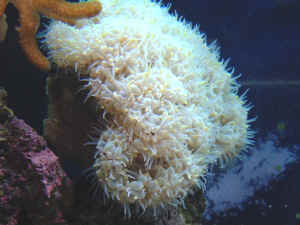 |
|
|

